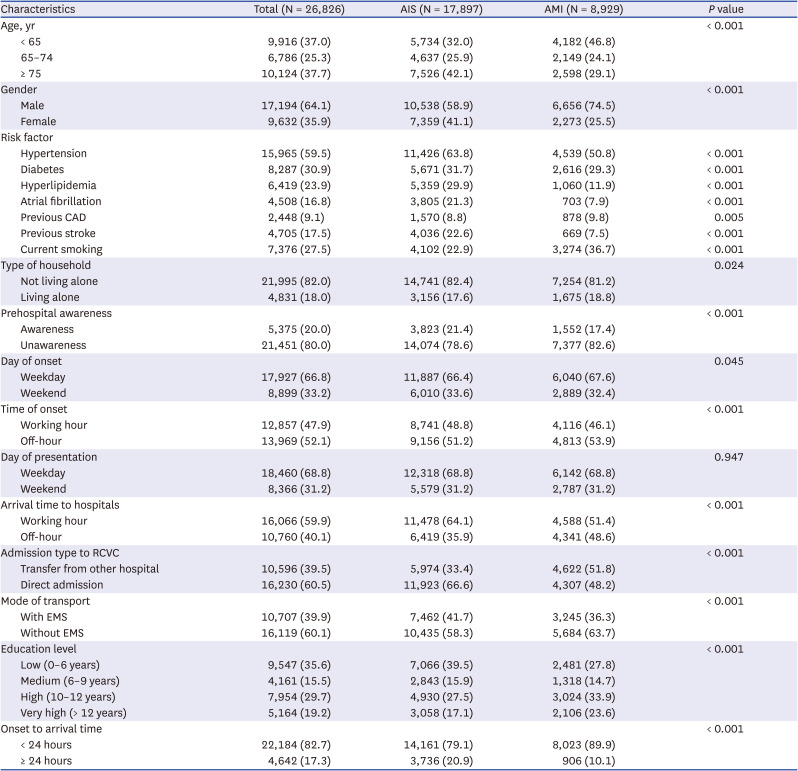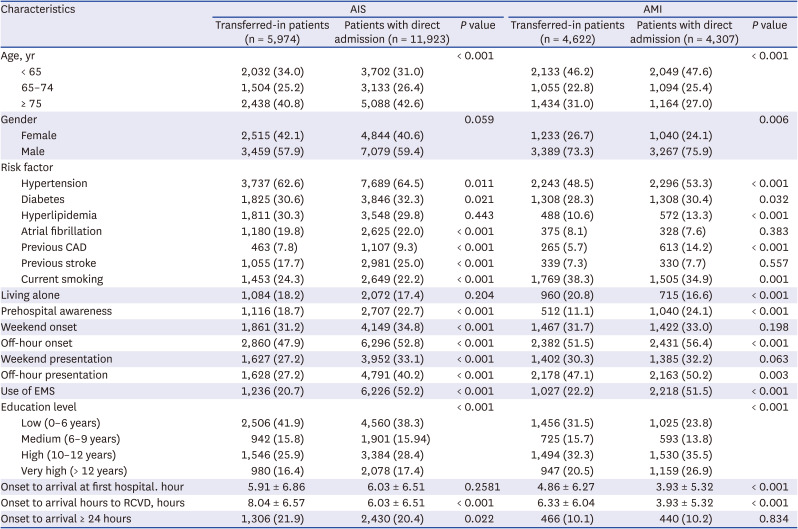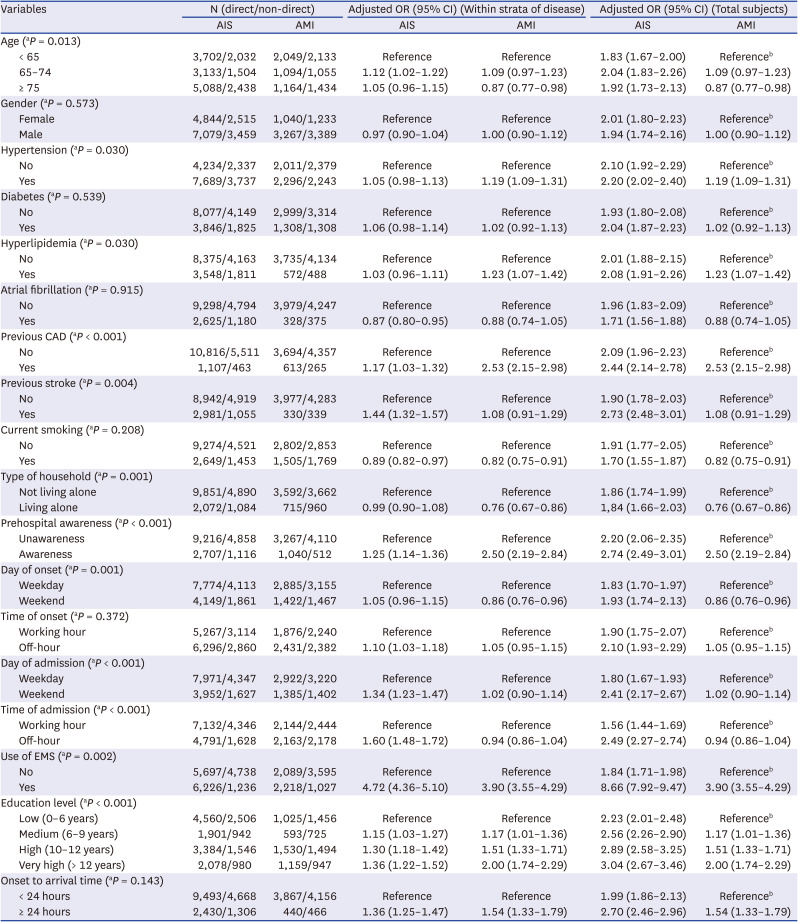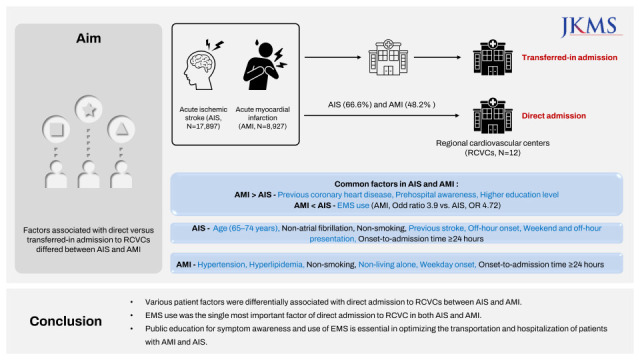1. O’Gara PT, Kushner FG, Ascheim DD, Casey DE Jr, Chung MK, de Lemos JA, et al. 2013 ACCF/AHA guideline for the management of ST-elevation myocardial infarction: a report of the American College of Cardiology Foundation/American Heart Association Task Force on practice guidelines. J Am Coll Cardiol. 2013; 61(4):e78–140. PMID:
23256914.
2. Powers WJ, Rabinstein AA, Ackerson T, Adeoye OM, Bambakidis NC, Becker K, et al. Guidelines for the early management of patients with acute ischemic stroke: 2019 update to the 2018 guidelines for the early management of acute ischemic stroke: a guideline for healthcare professionals from the American Heart Association/American Stroke Association. Stroke. 2019; 50(12):e344–e418. PMID:
31662037.
3. Meretoja A, Roine RO, Kaste M, Linna M, Roine S, Juntunen M, et al. Effectiveness of primary and comprehensive stroke centers: PERFECT stroke: a nationwide observational study from Finland. Stroke. 2010; 41(6):1102–1107. PMID:
20395609.
4. Mullen MT, Branas CC, Kasner SE, Wolff C, Williams JC, Albright KC, et al. Optimization modeling to maximize population access to comprehensive stroke centers. Neurology. 2015; 84(12):1196–1205. PMID:
25740858.
5. Kim J, Hwang YH, Kim JT, Choi NC, Kang SY, Cha JK, et al. Establishment of government-initiated comprehensive stroke centers for acute ischemic stroke management in South Korea. Stroke. 2014; 45(8):2391–2396. PMID:
24994720.
6. Cho SG, Kim Y, Choi Y, Chung W. Impact of regional cardiocerebrovascular centers on myocardial infarction patients in Korea: a fixed-effects model. J Prev Med Public Health. 2019; 52(1):21–29. PMID:
30742758.
7. Ali SF, Fonarow G, Liang L, Xian Y, Smith EE, Bhatt DL, et al. Rates, characteristics, and outcomes of patients transferred to specialized stroke centers for advanced care. Circ Cardiovasc Qual Outcomes. 2018; 11(9):e003359. PMID:
30354551.
8. Vora AN, Peterson ED, Hellkamp AS, Sutton NR, Panacek E, Thomas L, et al. Care transitions after acute myocardial infarction for transferred-in versus direct-arrival patients. Circ Cardiovasc Qual Outcomes. 2016; 9(2):109–116. PMID:
26812934.
9. Kim JY, Lee KJ, Kang J, Kim BJ, Kim SE, Oh H, et al. Acute stroke care in Korea in 2013-2014: national averages and disparities. J Korean Med Sci. 2020; 35(20):e167. PMID:
32449325.
10. Choi JC, Kim JG, Kang CH, Bae HJ, Kang J, Lee SJ, et al. Effect of transport time on the use of reperfusion therapy for patients with acute ischemic stroke in Korea. J Korean Med Sci. 2021; 36(11):e77. PMID:
33754510.
11. Kawecki D, Gierlotka M, Morawiec B, Hawranek M, Tajstra M, Skrzypek M, et al. Direct admission versus interhospital transfer for primary percutaneous coronary intervention in ST-segment elevation myocardial infarction. JACC Cardiovasc Interv. 2017; 10(5):438–447. PMID:
28216215.
12. Kang J, Kim SE, Park HK, Cho YJ, Kim JY, Lee KJ, et al. Routing to endovascular treatment of ischemic stroke in Korea: recognition of need for process improvement. J Korean Med Sci. 2020; 35(41):e347. PMID:
33107228.
13. Nickles AV, Roberts S, Shell E, Mitchell M, Hussain S, Lyon-Callo S, et al. Characteristics and outcomes of stroke patients transferred to hospitals participating in the Michigan Coverdell acute stroke registry. Circ Cardiovasc Qual Outcomes. 2016; 9(3):265–274. PMID:
27072678.
14. Gurwitz JH, Goldberg RJ, Malmgren JA, Barron HV, Tiefenbrunn AJ, Frederick PD, et al. Hospital transfer of patients with acute myocardial infarction: the effects of age, race, and insurance type. Am J Med. 2002; 112(7):528–534. PMID:
12015243.
15. Kim RB, Hwang JY, Park HW, Her AY, Lee JH, Kim MH, et al. Contemporary status of acute myocardial infarction in Korean patients: Korean registry of acute myocardial infarction for regional cardiocerebrovascular centers. J Clin Med. 2021; 10(3):498. PMID:
33535380.
16. Knol MJ, VanderWeele TJ. Recommendations for presenting analyses of effect modification and interaction. Int J Epidemiol. 2012; 41(2):514–520. PMID:
22253321.
17. Ali SF, Singhal AB, Viswanathan A, Rost NS, Schwamm LH. Characteristics and outcomes among patients transferred to a regional comprehensive stroke center for tertiary care. Stroke. 2013; 44(11):3148–3153. PMID:
24021682.
18. Zachrison KS, Onnela JP, Reeves MJ, Hernandez A, Camargo CA Jr, Zhao X, et al. Hospital factors associated with interhospital transfer destination for stroke in the Northeast United States. J Am Heart Assoc. 2020; 9(1):e011575. PMID:
31888430.
19. Park YH, Kang GH, Song BG, Chun WJ, Lee JH, Hwang SY, et al. Factors related to prehospital time delay in acute ST-segment elevation myocardial infarction. J Korean Med Sci. 2012; 27(8):864–869. PMID:
22876051.
20. Ekundayo OJ, Saver JL, Fonarow GC, Schwamm LH, Xian Y, Zhao X, et al. Patterns of emergency medical services use and its association with timely stroke treatment: findings from Get With the Guidelines-Stroke. Circ Cardiovasc Qual Outcomes. 2013; 6(3):262–269. PMID:
23633218.
21. Fladt J, Meier N, Thilemann S, Polymeris A, Traenka C, Seiffge DJ, et al. Reasons for prehospital delay in acute ischemic stroke. J Am Heart Assoc. 2019; 8(20):e013101. PMID:
31576773.
22. Kim YS, Park SS, Bae HJ, Cho AH, Cho YJ, Han MK, et al. Stroke awareness decreases prehospital delay after acute ischemic stroke in Korea. BMC Neurol. 2011; 11(1):2. PMID:
21211051.
23. Moser DK, Kimble LP, Alberts MJ, Alonzo A, Croft JB, Dracup K, et al. Reducing delay in seeking treatment by patients with acute coronary syndrome and stroke: a scientific statement from the American Heart Association Council on cardiovascular nursing and stroke council. Circulation. 2006; 114(2):168–182. PMID:
16801458.
24. Canto JG, Zalenski RJ, Ornato JP, Rogers WJ, Kiefe CI, Magid D, et al. Use of emergency medical services in acute myocardial infarction and subsequent quality of care: observations from the National Registry of Myocardial Infarction 2. Circulation. 2002; 106(24):3018–3023. PMID:
12473545.
25. Choi SW, Shin SD, Ro YS, Song KJ, Lee YJ, Lee EJ. Effect of emergency medical service use and inter-hospital transfer on time to percutaneous coronary intervention in patients with ST elevation myocardial infarction: a multicenter observational study. Prehosp Emerg Care. 2016; 20(1):66–75. PMID:
26727340.
26. Mathews R, Peterson ED, Li S, Roe MT, Glickman SW, Wiviott SD, et al. Use of emergency medical service transport among patients with ST-segment-elevation myocardial infarction: findings from the National Cardiovascular Data Registry Acute Coronary Treatment Intervention Outcomes Network Registry-Get with the Guidelines. Circulation. 2011; 124(2):154–163. PMID:
21690494.
27. Sheth KN. Early transfer of patients with stroke to comprehensive centers is necessary. Stroke. 2014; 45(12):3748–3749. PMID:
25388421.
28. Goyal M, Menon BK, Wilson AT, Almekhlafi MA, McTaggart R, Jayaraman M, et al. Primary to comprehensive stroke center transfers: appropriateness, not futility. Int J Stroke. 2018; 13(6):550–553. PMID:
29508654.
29. Wein TH, Staub L, Felberg R, Hickenbottom SL, Chan W, Grotta JC, et al. Activation of emergency medical services for acute stroke in a nonurban population: the T.L.L. Temple Foundation Stroke Project. Stroke. 2000; 31(8):1925–1928. PMID:
10926958.







 PDF
PDF Citation
Citation Print
Print




 XML Download
XML Download